Rhinoplasty in Istanbul Turkey Nose Job Price
Rhinoplasty in Turkey, Istanbul.
Rhinoplasty (nose job) surgery is a procedure to remove the deformities in the inner and outer curvature of the nose and render its look more harmonious with the rest of the face, aesthetical and attractive. The most frequently encountered deformities in the Turkish society are the dorsal hump and the nasal tip projection.
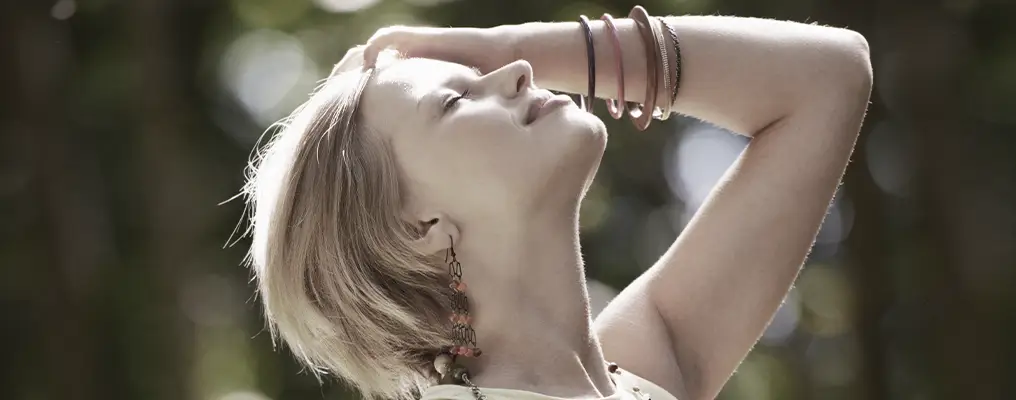
Click to see 10 days to 10 years after rhinoplasty.
It is the most frequently performed operation in our country. Its frequency is increasing day by day. Both the number of patients getting the operation and the doctors exercising the operation are increasing. Nose surgeries are performed by plastic surgeons and otorhinolaryngology specialists. Rather than from which department the physician is, how frequently he has performed the operation, in other words, how experienced he is and his perspective of aesthetics plays a more important role.
The main purpose of nose surgery is planning a functional nose that fits with the rest of the facial structures, is proprietary, attractive and breathing capable. The ideal nose profile of the person needs to be identified during the consultations prior to the operation. Thus nose specific professional pictures are taken. The patient's expectations and doctor's plans should be discussed in detail over the photos. Patient doctor communication is the most vital part in in reaching success in nose surgeries. Your demands and limits to the operation need to be examined.
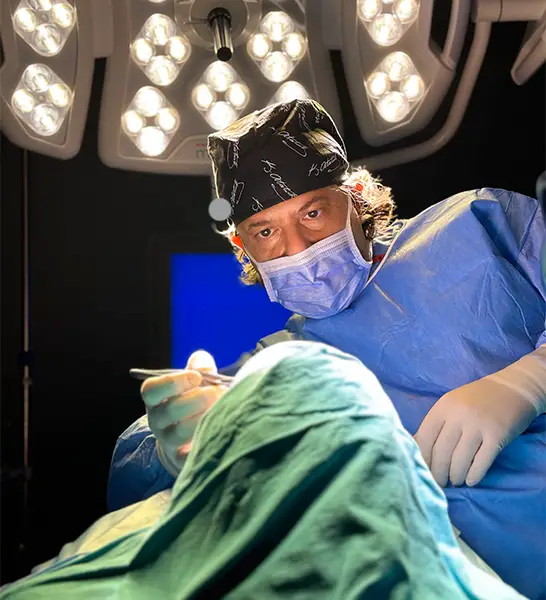
Nasal surgeries are generally applied under general anesthesia. They take about 2-3 hours. If no complaints persist for 4-6 hours following the operation, the patient is free to be discharged.
If any, the splints can be removed after 2-3 days. As silicone splints are utilized, generally no pain is experienced during removal and in addition, sedation is applied prior to the procedure.
Thus it improves convenience. Casts are removed between 5th and 7th day. Dressing is applied for three days. You may return to your regular lifestyle in the 10th day.
The pain often occurs in the form of pressure. Basic painkillers will suffice. Bruising occurs on the first day. It completely heals in a week. Nose surgery is not something that concludes right away.
It requires a year of follow-up. It is necessary to have good communication with your doctor until the desired outcome is achieved.
Glance to rhinoplasty (Reading time is about 1 minute)
|
Question |
Answer |
|
Anaesthetic type |
General or local with sedation. Typicially general anesthesia. |
|
Procedure time |
Generally 2-3 hours. Revision rhinoplasty may be more. |
|
Hospital stay |
Usually 1 day stay at hospital. |
|
Flying after surgery |
4-6 days after surgeon's clearance |
|
How to sleep after rhinoplasty |
On your back with head elevated, especially in initial recovery |
|
Nasal garment |
Nasal splint 7-10 |
|
Driving after rhinoplasty |
Typically 3-7 days after surgery. Ask your Turkish surgeon |
|
Sexual Activity |
Surgeon's clearance, usually after a few weeks |
|
Back to Work |
Varies, often 1 week depending on job |
|
Return to exercise |
Usually after 4-6 weeks, as advised by surgeon |
|
Rhinoplasty cost in Turkey |
$2,000 - $5,000 (varies by Turkey clinic) |
|
Safety in Turkey |
Generally safe, choose reputable clinics |
|
Full recovery time |
Several weeks to months for complete healing |
|
Final results |
Months to year, after swelling fully subsides |
|
Pain |
Managed with prescribed or OTC medications |
|
Crying |
Can increase swelling, manage with care |
|
Worth it |
Yes worth it to have, often transformative |
|
Success rate |
High, but varies based on surgeon's skill, typically 95 % |
|
Insurance cover? |
Rarely covered, typically considered cosmetic |
|
Natural results? |
Yes achievable, depends on surgeon's skill |
|
Suitable age |
Depends on individual case, often adults after 18 years old |
|
Any risk |
Risks exist, discuss with your surgeon |
|
Lifespan |
Permanent results, longlife. |
What is rhinoplasty?
Rhinoplasty, also referred to as a nose job, is a surgical procedure performed by a skilled plastic surgeon in Turkey. This procedure aims to reshape and transform the appearance of the nose, primarily for cosmetic reasons but occasionally addressing functional concerns, such as improving breathing after rhinoplasty
Typically conducted as an outpatient operation under general anesthesia, rhinoplasty has the potential to significantly enhance facial harmony and bolster self-confidence. While the rhinoplasty recovery time can vary among individuals, patients might experience temporary swelling and bruising for a few weeks post-surgery. In essence, rhinoplasty offers a versatile solution, addressing aesthetic preferences and functional improvements, ultimately achieving a more balanced and harmonious facial appearance.

Rhinoplasty types
- Augmentation rhinoplasty
- Tip rhinoplasty
- Rhinoplasty bridge reduction
- Laser rhinoplasty
- Revision rhinoplasty
- Non-surgical rhinoplasty also known as non surgical nose job,
- Filler rhinoplasty known as injectable rhinoplasty or liquid nose job,
- Injectable rhinoplasty
- Rhinoseptoplasty
- Reduction rhinoplasty
- Liquid nose job
Who is a good candidate for rhinoplasty?
Good candidates for rhinoplasty are individuals seeking to address cosmetic concerns or functional issues with their nose. Suitable candidates are given below:
- Those with congenital or acquired nasal abnormalities.
- Individuals with dissatisfaction with the appearance of their Breathing Issues: Individuals experiencing breathing difficulties due to nasal structural issues.nose.
- People with nose injuries resulting in deformities.
- When non-invasive methods fail to address aesthetic or functional concerns.
- Those affected psychologically by their nose's appearance.
- Individuals in good overall health for surgical procedures.
- Those with clear and realistic expectations about the outcomes.
- Individuals with age-related nasal changes seeking rejuvenation.
- Those with asymmetry or imbalance in nasal features.
People committed to postoperative care and recovery processes.
Who are not suitable for nose Job?
It's crucial to identify and address factors to ensure a safe and successful rhinoplasty procedure. Non suitable candidates for cosmetic rhinoplasty are as shown:
- Individuals with significant health challenges that pose risks for surgery.
- Those with severe mental health issues affecting their ability to cope with the procedure and recovery.
- Individuals whose facial features, including the nose, have not fully matured.
- People in overall poor health conditions that may hinder the surgical process.
- Individuals with unrealistic hopes about the outcomes of the rhinoplasty.
- Those actively smoking or using substances, as these can impact healing and results.
- Individuals unlikely to follow pre and postoperative guidelines for care.
- People facing constraints that may compromise the quality of care and follow-up.
- Individuals with skin conditions affecting the nasal area.
What are the advantages of rhinoplasty?
|
Benefits of rhinoplasty |
|
Enhanced nasal asymmetry |
|
Improved aesthetic nose |
|
Correction of breathing difficulties |
|
Rectification of airflow issues |
|
Enhanced social interaction |
|
Resolution of snoring issues |
|
Improved sleep quality due to reduced snoring |
Rhinoplasty, a versatile surgical procedure, addresses various concerns related to both form and function of the nose. From correcting congenital abnormalities and traumatic deformities to enhancing aesthetic features and resolving breathing issues, rhinoplasty offers a comprehensive solution for individuals seeking nasal improvement.
- Reshaping noses with inborn structural issues.
- Addressing breathing difficulties due to structural issues.
- Correction of breathing difficulties and nasal airway obstruction
- Nose correction and deviated septum
- Rectifying nasal appearance changes related to aging.
- Correcting unsatisfactory results from previous rhinoplasty procedures.
- Correcting nasal deformities and impaired breathing resulting from accidents or trauma.
- Treating nasal humps or bumps for improved appearance.
- Reconstruction for noses with asymmetry or crookedness.
- Adjusting wide or flared nostrils for a balanced look.
- Enhancing large or misshapen nasal tips for a more refined appearance.
- Modifying narrow or excessively wide bridges.
- Correcting surgical rhinoplasty performed previously.
How you prepare for rhinoplasty?
Preparing for rhinoplasty procedure involves careful planning and adherence to preoperative guidelines to ensure a smooth and successful procedure. Comprehensive preparation is key to both physical and mental readiness for the upcoming rhinoplasty.
- Schedule and attend a thorough consultation with your surgeon to discuss expectations and address any concerns.
- Provide a detailed medical history, including allergies, medications, and previous surgeries.
- Cease smoking and avoid tobacco products to promote better healing and reduce surgical risks.
- Discontinue blood-thinning medications, supplements, and herbal remedies as advised by your rhinoplasty surgeon.
- Aim to maintain a stable weight, as significant fluctuations can affect surgical outcomes.
- Plan for a reliable means of transportation on the day of surgery, as you won't be able to drive afterward.
- Set up a comfortable recovery space at home with essential items and support for the postoperative period.
- Adhere to fasting instructions provided by your surgeon to prepare for anesthesia.
- Arrange for someone to assist you during the initial recovery days, including transportation and daily activities.
- Communicate openly with your surgeon about any last-minute concerns or changes in health before the surgery date.
How is performed rhinoplasty procedure?
From anesthesia administration to incision placement, bone and cartilage adjustments, and postoperative care, the procedure is tailored to address individual concerns and create harmonious facial proportions.Formun Üstü
Anesthesia administration
The patient receives anesthesia to ensure comfort and prevent pain during the procedure.
Incision placement
Depending on the technique (open or closed), incisions are made either externally across the columella or internally within the nostrils. Closed rhinoplasty incisions are performed inside the nasal cavity with nostril surgery.
Access and visibility
In open rhinoplasty, the skin is lifted to provide direct visibility to nasal structures; in closed rhinoplasty, adjustments are made with limited internal visibility.
Bone and cartilage adjustment
Nasal bones and cartilage are manipulated called as closed rhinoplasty incisions, reshaped, or removed as needed to achieve the desired results. are made inside the nasal cavity with nostril surgery. Rhinoplasty cartilage removal is often performed during the surgery.
Grafts or implants
If necessary for structural support or augmentation, grafts or implants may be inserted at this stage during the nose reshaping surgery.
Incision closure
Incisions are meticulously closed (open rhinoplasty stitches ) by turkey dentists, with external incisions resulting in a small, inconspicuous scar beneath the nose.
What to do after rhinoplasty?
After rhinoplasty, prioritize rest and avoid intense physical activities for a few weeks. Elevate your head while sleeping to reduce swelling, and follow your surgeon's recommendations for pain management and nasal care. Attend all scheduled follow-up appointments to ensure proper healing and address any concerns promptly. Be patient—the full results may take several months to become apparent. Protect your nose from direct sunlight and avoid wearing glasses on the bridge until your surgeon gives the green light. Lastly, embrace self-care and allow yourself the time needed for a smooth recovery.
How much does a nose job cost?
|
Location |
Rhinoplasty cost |
|
Turkey noje job cost |
$2,000 - $5,000 |
|
Rhinoplasty uk cost |
$5,000 - $10,000 |
|
Nose job price in Europa |
$5,000 - $12,000 |
Rhinoplasty Turkey packages often include the surgical fee, pre-operative assessments, and post-operative care. These packages may also cover accommodation, transportation, and translation services, providing a comprehensive and convenient experience for international patients. All-inclusive Turkey packages may further encompass sightseeing and leisure activities, offering a holistic approach to medical tourism.
Factors affecting rhinoplasty costs in Turkey include the surgeon's expertise, clinic reputation, the complexity of the procedure, and additional services like accommodation and transportation. It's advisable to consult directly with clinics for precise and tailored cost estimates based on individual cases.
Is rhinoplasty painful?
No, rhinoplasty is not generally painful during the procedure, thanks to the use of local anesthesia.
Following rhinoplasty, discomfort levels, swelling, and bruising may vary among patients. Therefore, the extent of pain or discomfort can be felt differently from one individual to another. Pain management is typically attainable through prescribed or over-the-counter pain medications. Adhering to your physician's post-operative care guidelines is essential to minimize discomfort and facilitate a smooth recovery process.
Why do patients prefer Turkey for nose job surgery?
|
Turkey is popular due to: |
|
1. Expert surgeons |
|
2. Quality healthcare |
|
3. Captivating tourism |
|
4. Experienced staff |
|
5. Positive feedback |
Patients often choose Turkey for nose job surgery due to the combination of high-quality medical care and cost-effectiveness. The country boasts a reputation for skilled plastic surgeons who are experienced in rhinoplasty procedures. Additionally, the modern medical facilities and infrastructure contribute to a comfortable and well-supported surgical experience. Turkey's popularity as a medical tourism destination is also influenced by its beautiful landscapes and cultural attractions, offering patients a unique blend of healthcare and tourism.
Is rhinoplasty worth it?
Yes, rhinoplasty is a worthwhile procedure.
Many discover that it significantly boosts confidence and self-esteem by addressing both aesthetic and functional nasal concerns. However, the decision's value is subjective, contingent on individual goals and aspirations. The procedure not only addresses functional issues but also enhances facial harmony, resulting in a more pleasing overall appearance. Ultimately, opting for a nose job is a personal decision, and for those discontent with their nose's impact on confidence, the process can be transformative and incredibly fulfilling.
How long does rhinoplasty surgery take?
Typically, a rhinoplasty procedure lasts from around 60 minutes to 180 minutes, depending on the intricacy of the surgery and the specific alterations planned for the nose.
The duration varies, with simpler procedures, like minor cosmetic tweaks, often wrapping up more quickly, while complex cases involving substantial restructuring of the nasal framework may extend the surgical time. It's crucial to consult with a qualified plastic surgeon for a more precise estimate tailored to your unique situation during a pre-surgery consultation. Moreover, factors such as the surgeon's expertise, approach, and the type of anesthesia administered can also influence the surgical duration..
Rhinoplasty before & after photos
Rhinoplasty before and after photos in rhinoplasty are basically your sneak peek into the possibilities and potential outcomes. They're like the visual resume of rhinoplasty doctors giving you a solid idea of their skills and what kind of nose transformations they've pulled off before. It's not just about being impressed; it's about setting your own expectations and understanding the range of results.
Some benefits of nose job before and after photos
You will:
- Get a clear picture of what your nose could look like after the surgery.
- Gauge the proficiency of your surgeon or explore other practitioners to ensure you're in skilled hands.
- Use the photos to manage your expectations about the achievable changes in your nose.
- Evaluate how consistently the surgeon delivers results by examining a variety of cases.
- Gain confidence in your decision by seeing successful transformations similar to what you desire.
- Witness a variety of cases to understand the diversity of possible rhinoplasty outcomes and rhinoplasty healing
- Use the photos as a tool to discuss your preferences and aesthetic goals with your surgeon.
Consider before and after images as a valuable aid in making informed decisions about your procedure.
What is revision rhinoplasty?
Revision rhinoplasty is a surgical procedure performed by revision rhinoplasty specialist to correct or enhance the results of a previous rhinoplasty (nose job).
It is often sought by individuals who are dissatisfied with the outcome of their initial nose surgery or who experience functional or aesthetic issues postoperatively. The primary goal of revision rhinoplasty is to address any residual concerns, such as asymmetry, breathing difficulties, or undesired cosmetic results. This type of surgery requires a high level of expertise, as the nasal structures may have undergone alterations during the initial procedure, making the revision more complex. Additionally, careful communication between the patient and the surgeon is crucial to ensure realistic expectations and a satisfactory outcome.
Does rhinoplasty leave scars?
No, rhinoplasty typically does not leave visible external scars.
The majority of rhinoplasty procedures, especially those performed using the closed technique, involve incisions made inside the nose, ensuring that any resulting scars are hidden from view. However, in some cases, with the open rhinoplasty technique, a small scar may be present on the underside of the nose, although it tends to be inconspicuous.
Is Turkey safe for rhinoplasty?
Yes, Turkey is generally safe for rhinoplasty, with a well-established reputation for providing quality medical services.
The country has modern medical facilities and highly skilled plastic surgeons who adhere to international standards. Additionally, many medical facilities in Turkey cater to international patients, offering comprehensive care and support throughout the rhinoplasty journey.
Can a rhinoplasty fail?
Yes, while rhinoplasty is generally successful, it can fail. There is a possibility of outcomes not meeting the patient's expectations or complications arising.
A failed rhinoplasty can result from factors such as poor communication between the patient and the surgeon, unrealistic expectations, or unforeseen healing issues. It emphasizes the importance of thorough consultation, clear communication, and selecting a skilled surgeon to minimize the risk of dissatisfaction or complications.
How soon can you shower after rhinoplasty?
Showering after rhinoplasty typically varies but is generally around 48 hours after the surgery.
It is crucial to follow your surgeon's specific post-operative care instructions, as they may provide personalized guidance based on your individual case. Showering too soon or using hot water should be avoided to prevent potential complications during the early stages of the rhinoplasty recovery.
Can a nose job cause blindness?
No, the likelihood of a nose job causing blindness is extremely rare.
While all surgeries carry inherent risks, including infection and bleeding, the risk of blindness from a rhinoplasty is exceptionally low. Surgeons take extensive precautions to protect vital structures during the procedure, and serious complications leading to blindness are highly uncommon in the context of rhinoplasty.
Do doctors break your nose for rhinoplasty?
Yes, during rhinoplasty, doctors may intentionally fracture or break the nasal bones to reshape the nose and achieve the desired results.
This controlled technique, known as osteotomy, allows for the adjustment of the nasal structure. However, it's essential to note that this procedure is carefully planned and executed by skilled surgeons to ensure a controlled and precise outcome.
Does your nose smell after rhinoplasty?
No, the sense of smell is typically not affected after rhinoplasty.
The surgery primarily focuses on the external appearance of the nose and does not significantly impact the internal nasal structures responsible for smell. However, individual experiences may vary, and any concerns about changes in smell should be discussed with your surgeon during pre-operative consultations.
What is the most common age for rhinoplasty?
The most common age for rhinoplasty is often in the late teens to early twenties, as the nose has generally reached its full physical maturity by this time.
However, rhinoplasty can be performed at various ages depending on individual needs and circumstances. It's crucial to undergo the procedure when the patient is emotionally and physically mature enough to make informed decisions about their appearance.
How do you sleep after rhinoplasty?
After rhinoplasty, it is recommended to sleep with your head elevated at a 30 to 45-degree angle for the first few days. This helps minimize swelling and promotes a smoother recovery. Sleeping on your back is advisable to avoid putting pressure on the nose and to maintain proper healing.
What happens if you cry after rhinoplasty (Nose job)?
Crying after rhinoplasty can potentially increase swelling and bruising around the eyes and nose.
The physical act of crying may strain the facial muscles and exacerbate postoperative discomfort. It is advisable to try and minimize emotional stress and tears during the initial recovery period to support the healing process. If crying is unavoidable, using cold compresses and following your surgeon's postoperative care instructions can help manage any increased swelling or bruising.
What happens to rhinoplasty as you age?
As you age after rhinoplasty, your nose will naturally undergo changes due to the aging process and shifts in facial structures.
The skin might lose some of its elasticity, affecting the appearance of your nose. However, the fundamental changes made during rhinoplasty tend to endure, contributing to a lasting improvement. While the aging process may influence the overall look, the impact of rhinoplasty can still be noticeable and provide long-term satisfaction.
How can I reshape my nose without rhinoplasty (Nose job)?
Reshaping your nose without rhinoplasty involves some non-surgical methods. You can use makeup to contour and highlight certain areas, creating the illusion of a different nose shape. Nose exercises, like pinching and shaping, may help improve muscle tone around the nose. Some people explore dermal fillers to temporarily adjust the appearance of the nose. Hairstyling can also play a role – bangs or certain hairstyles can draw attention away from the nose. Remember, while these tricks can offer temporary changes, they're not permanent like rhinoplasty.
How long should I wait to return to exercise?
After rhinoplasty, it's generally recommended to wait at least two to four weeks before resuming strenuous exercise.
Give your body the necessary time to heal and reduce the risk of complications. Start with light activities like walking and gradually reintroduce more intense exercises as advised by your surgeon. Always consult with your surgeon before resuming any exercise routine to ensure a safe and smooth recovery.
Is rhinoplasty covered by health insurance?
In most cases, rhinoplasty is considered a cosmetic procedure and is not covered by health insurance.
Insurance typically covers procedures that are medically necessary, and rhinoplasty is often performed for aesthetic reasons. However, if the surgery is required for functional reasons, such as correcting a breathing problem, insurance may provide coverage. It's crucial to check with your insurance provider and discuss the specific details with your surgeon to determine coverage eligibility.
Will my breathing be affected by rhinoplasty surgery?
Yes, breathing can be affected temporarily after rhinoplasty due to swelling and congestion, but this usually improves as the nose heals.
In cases where rhinoplasty is done to address breathing issues, the surgery can actually enhance breathing in the long run. It's crucial to follow your surgeon's post-operative care instructions, which may include nasal irrigation and avoiding activities that could strain the nose during the initial recovery period. If you have concerns about breathing changes after rhinoplasty, discuss them with your surgeon during the consultation to ensure your expectations align with the potential outcomes.
What types of anesthesia are used during a rhinoplasty?
During rhinoplasty, you'll typically have two anesthesia options: general anesthesia, where you're completely asleep during the procedure, or local anesthesia with sedation, where your nose is numbed, and you're in a relaxed state. The choice depends on factors like the extent of the surgery and your comfort level. Your surgeon will discuss the options with you and recommend the most suitable anesthesia based on your specific case.
Can I drive home after my rhinoplasty?
No, you should not drive yourself home after rhinoplasty.
The anesthesia and postoperative medications can impair your ability to operate a vehicle safely. Arrange for someone to drive you home after the procedure to ensure your safety and a smooth transition into the initial stages of recovery.
What can I eat and drink after my rhinoplasty?
After rhinoplasty, opt for soft and easily digestible foods to avoid putting strain on your jaw. Soups, smoothies, yogurt, and mashed potatoes are good choices. Stay hydrated by drinking plenty of water, but avoid using straws in the first few days to prevent any unnecessary pressure on the nose. It's best to steer clear of spicy, hot, or hard foods during the initial recovery period. Always follow your surgeon's dietary guidelines to ensure a smooth healing process.
When can I fly after a rhinoplasty?
No, it is generally not advisable to fly immediately after rhinoplasty.
Most surgeons recommend waiting at least one to two weeks before flying to allow for the initial stages of healing and minimize the risk of complications such as increased swelling or changes in pressure affecting the nose. Prolonged periods of immobility during flights can contribute to blood clots, so it's crucial to discuss your travel plans with your surgeon and follow their recommendations for a safe and comfortable recovery.
When will I see the final results of my rhinoplasty?
You will se final results of your rhinoplasty several months to a year later to fully manifest.
While you'll notice improvements in the appearance of your nose relatively soon after the surgery, the complete resolution of swelling and the settling of tissues can take time. Patience is key, and it's essential to follow your surgeon's post-operative instructions for optimal healing and to achieve the final, satisfying results.
What questions should I ask my plastic surgeon about rhinoplasty?
Navigating a rhinoplasty journey involves informed decision-making, and arming yourself with the right questions is crucial. Here are key inquiries to consider when consulting with your plastic surgeon to ensure clarity, confidence, and a thorough understanding of the rhinoplasty process.
- What are the expected outcomes with this surgical approach, and can you explain them to ensure I understand the potential results?
- How do you handle complications that may arise during or after the rhinoplasty procedure, outlining your approach to managing risks and complications?
- What is the typical recovery time for rhinoplasty, and what should I expect during the immediate post-operative period to plan for post-surgery downtime?
- Will there be visible scarring, and if so, where, and how do you minimize scarring with various scar management techniques?
- What is the total cost of the rhinoplasty procedure, including all fees, and do you offer financing options or payment plans for financial clarity?
- Where will the nose operation take place, and is the facility accredited and equipped to ensure safety and quality during rhinoplasty surgery?
- What type of anesthesia will be used during the surgery, and who will administer and monitor the anesthesia to ensure qualified personnel?
- Can I see before-and-after photos of patients with similar nasal issues to evaluate your work, and what can I realistically expect in terms of results?
- What post-operative care instructions should I follow, including any restrictions on activities, diet, or medication, to understand aftercare and post-surgery limitations?
- How many follow-up appointments will be necessary, and when will they occur, and how will you assess my healing progress during these visits?
- Are there non-surgical alternatives or less invasive procedures to address my concerns, and can you outline a personalized treatment plan for my specific goals and needs to customize the approach?
- Can you provide references from previous rhinoplasty patients I can contact for their feedback, and what realistic expectations should I have regarding the outcome of my rhinoplasty procedure?
Rhinoplasty risks
While surgical rhinoplasty can yield transformative results, it is important to acknowledge the potential risks associated with the procedure, ranging from aesthetic concerns to complications impacting functionality.
- Potential complications may include nasal asymmetry in the appearance of the nose.
- Bleeding can occur after the rhinoplasty procedure, requiring attention.
- There is a possibility of developing various infections following plastic surgery.
- Prolonged inflammation and discoloration may persist beyond the expected recovery period.
- Certain issues with the skin, apart from scarring, may emerge as a complication.
- Scarring is a potential outcome, influencing the aesthetic result of the nose job.
- Problems with anesthesia administration may pose risks during the surgical process.
- Rhinoplasty may lead impaired Breathing
- Altered sensation, such as numbness or heightened sensitivity, can occur.
- Dissatisfaction with the final aesthetic outcomes is a conceivable complication.
- There's a potential risk of developing a septal perforation, impacting nasal structure.
- Some individuals may require additional surgery to address unsatisfactory results or complications.
10 days and 2 weeks after rhinoplasty
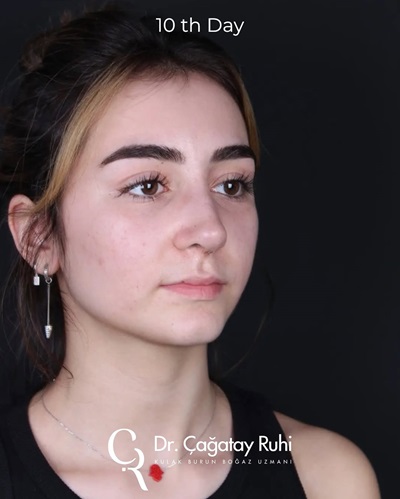
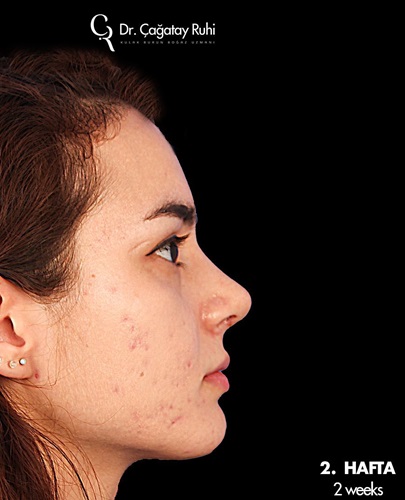
1 and 2 months after rhinoplasty
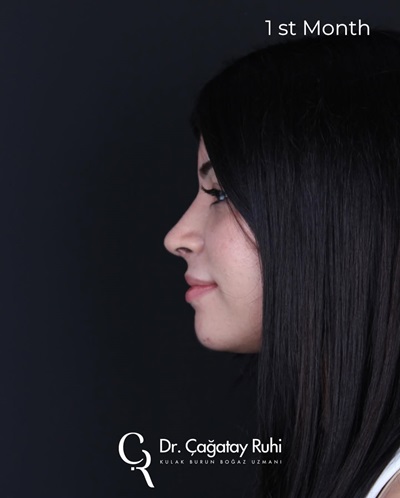

4 and 6 months after rhinoplasty
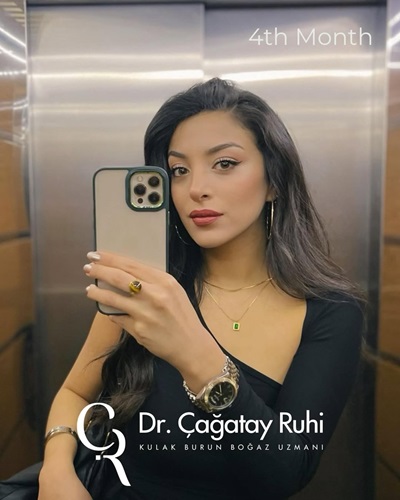
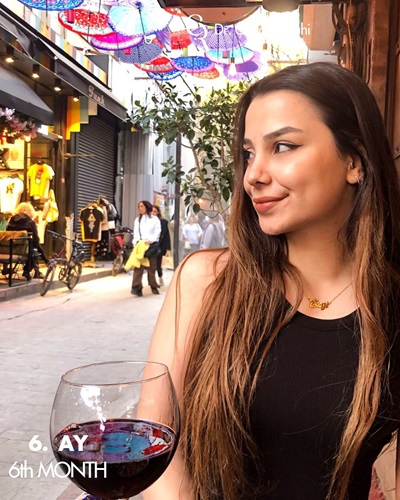
8 months and 1 year after rhinoplasty

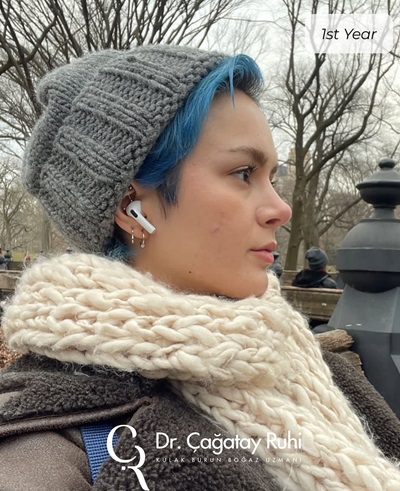
2 and 3 years after rhinoplasty

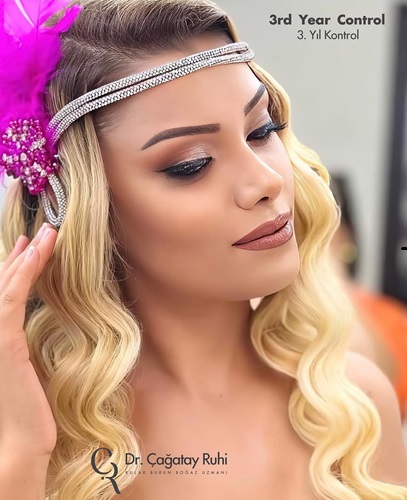
4 and 5 years after rhinoplasty
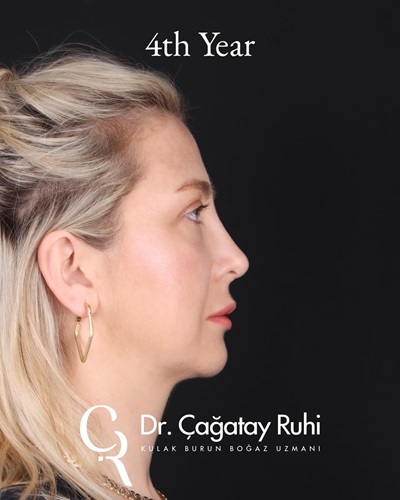
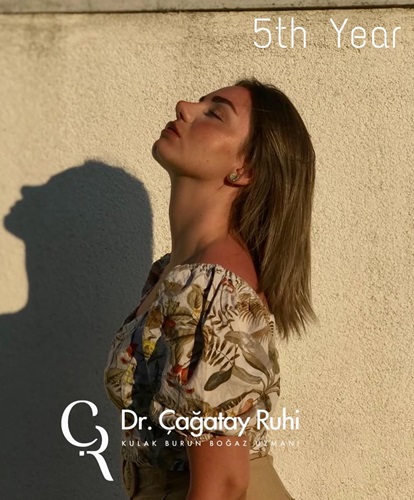
7 and 10 years after rhinoplasty
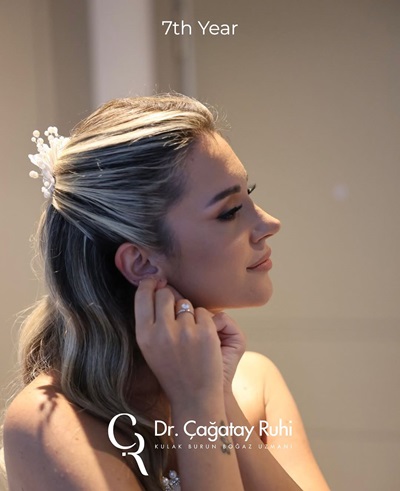
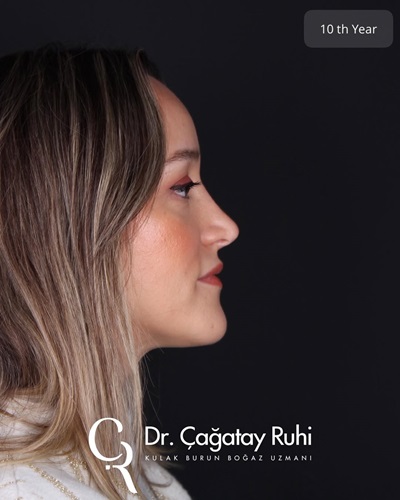
If you are not happy about the shape of your nose and you are suffering from nasal congestion in addition to that, don't hesitate to decide for nose surgery. Nose surgery is at the forefront of the most successful aesthetic operations in experienced hands. Remember, if there is an aesthetic deformity in your nose, then there is often a functional disorder accompanying it. You can also endowed with a healthy and natural looking, attractive and beautiful nose by means of the opportunities offered by medicine.

